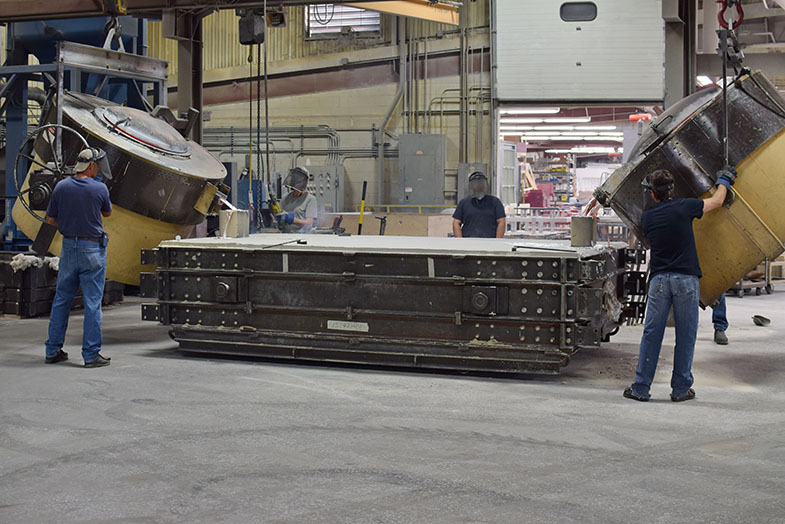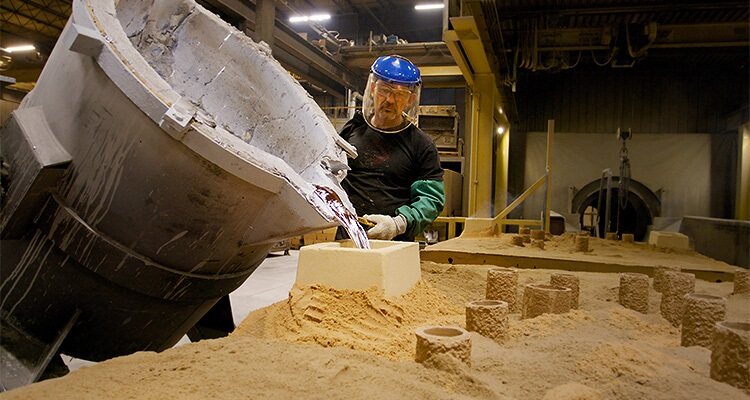Everything About Aluminum Foundry: Trick Utilizes and Its Effect on Product Development
Aluminum foundries are vital in modern-day manufacturing, particularly in sectors such as vehicle and aerospace. They utilize innovative methods to develop lightweight, sturdy elements that improve efficiency. The flexibility of aluminum likewise aligns with sustainability initiatives, making it a preferred material. The recurring innovations in casting methods and their implications for item advancement raising essential inquiries. What future innovations might improve the landscape of aluminum foundries and their applications?
Introduction of Aluminum Foundries
Aluminum foundries function as important centers in the metalworking sector, focusing on the casting of aluminum and its alloys. These centers use numerous techniques, including sand casting, die casting, and investment casting, to transform raw aluminum right into useful kinds. Each casting strategy provides unique advantages, dealing with different task needs varying from small components to huge architectural elements.
The foundries operate through a precise procedure that begins with melting aluminum, followed by pouring the liquified metal into mold and mildews. After cooling down, the castings go through ending up processes, which may include machining and surface treatment to fulfill precise requirements.
Quality control is critical, making certain that the final products satisfy sector requirements and client assumptions. Additionally, aluminum foundries frequently stress sustainability by reusing scrap aluminum, consequently minimizing waste and conserving resources. This commitment to efficient production and environmental obligation placements aluminum foundries as crucial contributors to the manufacturing landscape.

Secret Applications of Aluminum Castings
Aluminum castings offer important duties in various sectors, especially in auto and aerospace markets. In the auto industry, they add to light-weight structures and reliable efficiency. Aerospace element production counts on aluminum castings for their strength and deterioration resistance, crucial for high-performance applications.
Automotive Market Applications
In the automotive market, aluminum castings play a critical role in enhancing vehicle performance and efficiency. These castings are extensively utilized for elements such as engine blocks, transmission real estates, and suspension parts. Their light-weight nature adds to minimized vehicle weight, which in turn improves gas economic situation and handling. Additionally, aluminum's outstanding thermal conductivity enables efficient warmth dissipation, crucial for high-performance engines. The rust resistance of aluminum likewise prolongs the life-span of vehicle components, reducing maintenance expenses. Additionally, developments in casting innovations make it possible for the production of intricate shapes, optimizing the design and capability of components. In general, aluminum castings are essential to contemporary auto engineering, sustaining technology and sustainability in car design.
Aerospace Component Manufacturing
The aerospace industry significantly depends on aluminum castings for an array of important parts as a result of their advantageous buildings. Lightweight yet strong, aluminum castings enhance gas performance and general performance in airplane style. Elements such as engine mounts, structural frames, and landing gear are frequently created using aluminum casting methods, allowing manufacturers to accomplish complex geometries while keeping architectural stability. The high resistance to deterioration and thermal homes of aluminum also contribute to the durability and dependability of aerospace parts. Furthermore, improvements in casting modern technologies, such as precision casting and 3D printing, have increased the capacities of aluminum in this industry. Eventually, aluminum castings play an essential role in meeting rigid safety and security standards and performance requirements in modern aerospace applications.
Advantages of Utilizing Aluminum in Production
While countless products are readily available for manufacturing, aluminum stands apart because of its special mix of residential or commercial properties that improve effectiveness and performance. One considerable advantage of aluminum is its lightweight nature, which adds to reduced power intake and boosted gas performance in numerous applications. Furthermore, aluminum displays excellent deterioration resistance, expanding the life-span of items and minimizing upkeep expenses. Its high thermal and electrical conductivity makes it appropriate for warmth exchangers and electric elements, while its malleability permits for functional styles and elaborate forms.
Aluminum is recyclable, promoting sustainability in manufacturing procedures. This reusability not just saves resources but additionally decreases the carbon footprint connected with manufacturing. The adaptability of aluminum to different alloys additionally enhances its utility in diverse industries, from auto to customer electronics. Collectively, these characteristics make aluminum an ideal selection for makers seeking to stabilize performance, cost-effectiveness, and environmental duty.
Technologies in Casting Methods
Recent innovations in casting methods have substantially transformed the aluminum foundry market. The integration of have a peek here 3D printing modern technology has made it possible for much more complex styles, while enhanced alloy formulas improve efficiency and sturdiness. These innovations are driving effectiveness and expanding the applications of aluminum in different sectors.
3D Printing Combination

Improved Alloy Solutions
Improvements in aluminum foundry modern technology have actually resulted in the development of enhanced alloy formulations that boost casting performance and product properties. These ingenious formulations often include elements such as silicon, magnesium, and copper, which maximize stamina, ductility, and deterioration resistance. By fine-tuning the structures, manufacturers can accomplish specific features tailored to varied applications, from automotive to aerospace sectors. Additionally, these enhanced alloys facilitate much better fluidness during the casting process, minimizing defects and improving surface area finish. Therefore, the efficiency of production is substantially enhanced while preserving stringent high quality criteria. This advancement in alloy development not just simplifies manufacturing however additionally sustains the creation of lighter, stronger elements, inevitably advancing product advancement and efficiency.
Effect on Aerospace and Automotive Industries
The noteworthy effect of aluminum foundries on the aerospace and auto sectors can not be overstated. Aluminum alloys, known for their lightweight and high stamina, have actually revolutionized the design and production procedures in both markets. In aerospace, the decrease in weight directly associates to fuel performance, enabling for longer trips and reduced emissions. Components such as aircraft frames, wings, and engine parts gain from aluminum's superb Aluminum Foundry tiredness resistance and deterioration resistance.
In the automobile sector, aluminum foundries contribute to the manufacturing of lighter automobiles, improving performance and gas economy while fulfilling rigid environmental laws. Making use of aluminum in engine blocks, body panels, and wheels has raised significantly, driven by consumer demand for extra reliable cars. Furthermore, developments in casting methods have actually boosted the precision and performance of parts, allowing producers to develop even more incorporated and complicated layouts, consequently fostering innovations in both sectors.
Sustainability Practices in Aluminum Foundries
Aluminum foundries are increasingly embracing sustainability practices to minimize their ecological impact while meeting the expanding needs of the aerospace and automobile industries. These methods include the application of energy-efficient technologies, such as electric melting heaters and progressed warmth recuperation systems, which greatly lower power intake (Aluminum Foundry). Furthermore, several foundries are focusing on the usage of recycled aluminum, which calls for much less energy and causes lowered greenhouse gas emissions compared to key aluminum production
Water conservation campaigns are also acquiring traction, with foundries utilizing closed-loop systems to lessen water use and stop contamination. Additionally, waste management strategies, consisting of reusing scrap and decreasing contaminated materials, add to a more lasting operation. By adopting these methods, aluminum foundries not only improve their competitiveness however additionally straighten with international sustainability objectives, inevitably supporting a round economic situation and fostering technology in eco friendly manufacturing procedures.
Future Patterns in Aluminum Casting Modern Technology
As the demand for lightweight and sturdy materials remains to rise, advancements in casting innovation are positioned to improve the aluminum market. Advanced strategies such as 3D printing and automated casting processes are obtaining traction, permitting for much more intricate geometries and decreased product waste. The combination of expert system and artificial intelligence is additionally improving quality control and procedure optimization, lessening problems and enhancing efficiency.
The advancement of new aluminum alloys is expanding the application variety of actors products, making them appropriate for sectors from automobile to aerospace. Improved recycling approaches are anticipated to better minimize environmental influences, aligning with global sustainability objectives.
Furthermore, using smart sensing units in casting procedures is expected to enable real-time tracking, making sure better precision and uniformity. These trends indicate a transformative era in aluminum casting technology, allowing suppliers to meet developing market needs while focusing on sustainability and advancement.
Regularly Asked Concerns
Exactly How Is Aluminum Recycled After Usage in Products?
Aluminum recycling includes gathering, sorting, and melting made use of aluminum items (Aluminum Foundry). The liquified steel is after that cast into new types, minimizing energy usage and preserving natural deposits, making it an effective and lasting procedure for aluminum healing
What Safety And Security Procedures Are Applied in Aluminum Foundries?
Security measures in aluminum foundries consist of appropriate air flow systems, personal safety tools, routine safety training, tools maintenance methods, and emergency situation response plans, all focused on reducing threats associated with high temperatures and dangerous materials throughout production.
How Do Aluminum Foundries Make Certain Quality Assurance?
Aluminum foundries execute rigorous quality useful site assurance processes, including product assessments, temperature tracking, and dimensional checks. These steps guarantee product consistency, minimize issues, and stick to market standards, eventually enhancing client complete satisfaction and functional performance.
What Are Common Difficulties Encountered by Aluminum Foundries?
Aluminum foundries typically encounter challenges such as preserving regular high quality, taking care of manufacturing costs, ensuring prompt distribution, addressing tools upkeep, and adapting to developing sector guidelines. These factors can substantially impact total operational efficiency and earnings.
Exactly How Does Aluminum Casting Affect Product Weight?
Aluminum casting considerably decreases product weight due to aluminum's reduced thickness contrasted to other steels - Aluminum Foundry. This light-weight particular boosts style versatility, boosts gas effectiveness in transportation applications, and provides advantages in various sectors calling for weight-sensitive parts